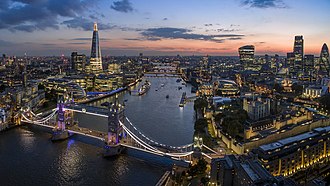TLV to London - Heathrow (LHR)
United Kingdom
London
CityLHR
IATA3593.4 km
Distance4h 50m
Flight TimeCoordinates: 51.4706, -0.46194
Airlines:
About London

Capital of England and the United Kingdom
London is the capital and largest city of both England and the United Kingdom, with a population of 9.1 million people in 2024. Its wider metropolitan area is the largest in Western Europe, with a population of 15.1 million. London stands on the River Thames in southeast England, at the head of a 50-mile (80 km) tidal estuary down to the North Sea, and has been a major settlement for nearly 2,000 years. Its ancient core and financial centre, the City of London, was founded by the Romans as Londinium and has retained its medieval boundaries. The City of Westminster, to the west of the City of London, has been the centuries-long host of the national government and parliament. London grew rapidly in the 19th century, becoming the world's largest city at the time. Since the 19th century the name "London" has referred to the metropolis around the City of London, historically split between the counties of Middlesex, Essex, Surrey, Kent and Hertfordshire, which since 1965 has largely comprised the administrative area of Greater London, governed by 33 local authorities and the Greater London Authority.
🌐 Read more on WikipediaWeather in London
The End (sculpture)
The End (stylised in all caps) is a sculpture by British artist Heather Phillipson, which was installed on the fourth plinth at Trafalgar Square, London, from 2020 to 2022. The scu…
Statue of Captain James Cook, The Mall
A bronze statue of Captain James Cook by Thomas Brock is located near Admiralty Arch on the south side of The Mall in London, United Kingdom. The statue was completed in 1914 and i…
1973 UCI Cyclo-cross World Championships
The 1973 UCI Cyclo-cross World Championships were held in London, England on Sunday February 25, 1973. Organized for a first time in the United Kingdom, it was the 24th edition of …
Statue of Henry Havelock, Trafalgar Square
A bronze statue of Henry Havelock by the sculptor William Behnes, stands in Trafalgar Square in London, United Kingdom. It occupies one of the four plinths in Trafalgar Square, th…
Acme Studios
Acme, also styled ACME, is a charity based in London, England which provides affordable studio and living space, residencies and awards for visual artists. Its studios are known as…
Trafalgar Square Christmas tree
The Trafalgar Square Christmas tree is a Christmas tree given to the people of London by the city of Oslo each year since 1947. The tree is prominently displayed in Trafalgar Squar…
Admiralty Arch
The Admiralty Arch is a historic landmark building in London, providing road and pedestrian access between The Mall, which extends to the southwest, and Trafalgar Square to the nor…
Equestrian statue of George IV, Trafalgar Square
The statue of George IV in Trafalgar Square, London, is a bronze equestrian statue by Sir Francis Legatt Chantrey. It depicts the King dressed in ancient Roman attire and riding ba…
Equestrian statue of Charles I, Charing Cross
The equestrian statue of Charles I at Charing Cross, London, England, is a work by the French sculptor Hubert Le Sueur, probably cast in 1633 during Charles’ lifetime. It is the ol…
Social Market Foundation
The Social Market Foundation (SMF) is an independent British political public policy think-tank based in Westminster, London. It is one of the 'Top 12 Think Tanks in Britain' and w…
Dump Trump (statue)
Dump Trump is a 16 feet (4.9 m) high statue of United States president Donald Trump sitting on a golden toilet. The sculpture was temporarily installed in Central London's Trafalga…
The Trafalgar St. James London
The Trafalgar St. James London, Curio Collection by Hilton is a contemporary boutique hotel located on the south side of Trafalgar Square in the City of Westminster, Central London…
Nelson's Column
Nelson's Column is a monument in Trafalgar Square in the City of Westminster, Central London, England, United Kingdom, built to commemorate British Royal Navy officer Horatio Nelso…
Fourth plinth
The fourth plinth is the northwest plinth in Trafalgar Square in central London. It was originally intended to hold an equestrian statue of William IV, but remained empty due to la…
Royal Marines Memorial
The Royal Marines Memorial, also known as the Graspan Royal Marines Memorial, is an outdoor bronze sculpture by Adrian Jones, installed on the north side of The Mall in London, Uni…
Canada House
Canada House (French: Maison du Canada) is a Greek Revival building on Trafalgar Square in London. It has been a Grade II* Listed Building since 1970. It has served as the chancery…
Statue of Charles James Napier, Trafalgar Square
A bronze statue of Charles James Napier by the sculptor George Gammon Adams stands in Trafalgar Square in London, United Kingdom. It occupies one of the four plinths in Trafalgar S…
Farmers Club
The Farmers Club is a private members' club that was founded in 1842. It is located at 3 Whitehall Court in the Whitehall district of London, England. Members are required to have …
Craig's Court
Craig's Court is a courtyard off Whitehall in central London containing the grade II* listed Harrington House (c.1692), other listed buildings, and the British Telecom Whitehall te…
One & Other
One & Other was a public art project by Antony Gormley, in which 2,400 members of the public occupied the usually vacant fourth plinth in Trafalgar Square, London, for an hour each…
The Mud Soldier
The Mud Soldier was an artwork by Damian and Killian Van Der Velden (Grofweg Architecten) displayed in Trafalgar Square. It was commissioned to commemorate the 100th anniversary of…














